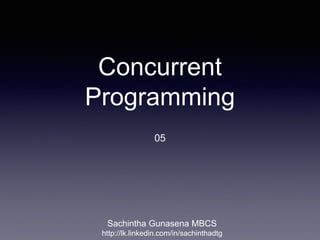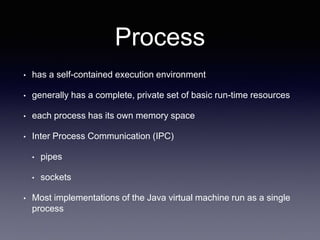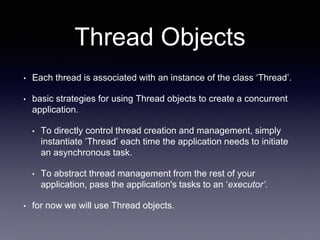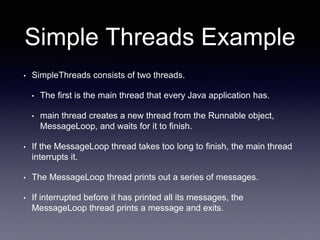Concurrency Programming in Java - 05 - Processes and Threads, Thread Objects, Thread Start, Sleep, Interrupt
- 3. Today’s Session • Processes and Threads • Thread Objects • Defining and Starting a Thread • Pausing Execution with Sleep • Interrupts • Joins • The SimpleThreads Example • Synchronization • Thread Interference • Memory Consistency Errors
- 5. Process • has a self-contained execution environment • generally has a complete, private set of basic run-time resources • each process has its own memory space • Inter Process Communication (IPC) • pipes • sockets • Most implementations of the Java virtual machine run as a single process
- 6. Thread • lightweight processes • provide an execution environment • requires fewer resources than creating a new process • exist within a process • every process has at least one - main thread • share the process's resources, including memory and open files
- 8. Thread Objects • Each thread is associated with an instance of the class ‘Thread’. • basic strategies for using Thread objects to create a concurrent application. • To directly control thread creation and management, simply instantiate ’Thread’ each time the application needs to initiate an asynchronous task. • To abstract thread management from the rest of your application, pass the application's tasks to an ‘executor’. • for now we will use Thread objects.
- 9. Defining & Running a Thread • An application that creates an instance of ‘Thread’ must provide the code that will run in that thread. • There are two ways to do this: • Provide a Runnable object. • The Runnable interface defines a single method, run, meant to contain the code executed in the thread. • The Runnable object is passed to the Thread constructor. • Subclass Thread. • The Thread class itself implements Runnable, though its run method does nothing. • An application can subclass Thread, providing its own implementation of run.
- 10. Using a Runnable Object public class HelloRunnable implements Runnable { public void run() { System.out.println("Hello from a thread!"); } public static void main(String args[]) { (new Thread(new HelloRunnable())).start(); } }
- 11. Using a Subclass of Thread public class HelloThread extends Thread { public void run() { System.out.println("Hello from a thread!"); } public static void main(String args[]) { (new HelloThread()).start(); } }
- 12. Runnable Object vs Thread Subclass • both invoke thread.start() to start a new thread • creating a Runnable Object • can subclass a class other than Thread • separates Runnable task from Thread object • more flexible • applicable to high-level thread management APIs • creating a Thread subclass • is easier to use in simple applications • is limited cause the task class must be a descendant of Thread
- 13. Thread Class • The Thread class defines a number of methods useful for thread management. • These include static methods, which • provide information about, or • affect the status of, • the thread invoking the method. • The other methods are invoked from other threads involved in managing the thread and Thread object.
- 14. Pausing Execution with Sleep • Thread.sleep causes the current thread to suspend execution for a specified period. • making processor time available to the other threads of an application or other applications • The sleep method can also be used for • pacing (rate of movement/activity), and • waiting for another thread • with duties that are understood to have time requirements
- 15. Pausing Execution with Sleep Cont.d • Two overloaded versions of sleep are provided: • one that specifies the sleep time to the millisecond • and one that specifies the sleep time to the nanosecond. • sleep times are not guaranteed to be precise • limited by the facilities provided by the underlying OS • sleep period can be terminated by interrupts • In any case, you cannot assume that invoking sleep will suspend the thread for precisely the time period specified.
- 16. Sleep Example public class SleepMessages { public static void main(String args[]) throws InterruptedException { String importantInfo[] = { "Mares eat oats", "Does eat oats", "Little lambs eat ivy", "A kid will eat ivy too" }; for (int i = 0; i < importantInfo.length; i++) { //Pause for 4 seconds Thread.sleep(4000); //Print a message System.out.println(importantInfo[i]); } } }
- 17. Sleep Example Cont.d • This example uses sleep to print messages at four- second intervals • main declares that it throws InterruptedException. • exception thrown when another thread interrupts the current thread while sleep is active • Since this application has not defined another thread to cause the interrupt, it doesn't bother to catch InterruptedException
- 18. Interrupts • an indication to a thread that it should stop what it is doing and do something else. • It's up to the programmer to decide exactly how a thread responds to an interrupt, • but it is very common for the thread to terminate • a thread sends an interrupt by invoking interrupt on the Thread object for the thread to be interrupted. • For the interrupt mechanism to work correctly, the interrupted thread must support its own interruption.
- 19. Supporting Interruption • How does a thread support its own interruption? • depends on what it's currently doing. • If the thread is frequently invoking methods that throw InterruptedException, it simply returns from the run method after it catches that exception. • For example, suppose the central message loop in the SleepMessages example were in the run method of a thread's Runnable object. • Then it might be modified as follows to support interrupts:
- 20. Supporting Interruption Cont.d for (int i = 0; i < importantInfo.length; i++) { // Pause for 4 seconds try { Thread.sleep(4000); } catch (InterruptedException e) { // We've been interrupted: no more messages. return; } // Print a message System.out.println(importantInfo[i]); }
- 21. Supporting Interruption Cont.d • Many methods that throw InterruptedException, such as sleep, are designed to cancel their current operation and return immediately when an interrupt is received. • What if a thread goes a long time without invoking a method that throws InterruptedException? • Then it must periodically invoke Thread.interrupted, • which returns true if an interrupt has been received.
- 22. Supporting Interruption Cont.d for (int i = 0; i < inputs.length; i++) { heavyCrunch(inputs[i]); if (Thread.interrupted()) { // We've been interrupted: no more crunching. return; } }
- 23. Supporting Interruption Cont.d • In this simple example, the code simply tests for the interrupt and exits the thread if one has been received. • In more complex applications, it might make more sense to throw an InterruptedException: • This allows interrupt handling code to be centralized in a catch clause. if (Thread.interrupted()) { throw new InterruptedException(); }
- 24. Interrupt Status Flag • The interrupt mechanism is implemented using an internal flag known as the interrupt status. Invoking Thread.interrupt sets this flag. • When a thread checks for an interrupt by invoking the static method Thread.interrupted, interrupt status is cleared. • The non-static isInterrupted method, which is used by one thread to query the interrupt status of another, does not change the interrupt status flag. • By convention, any method that exits by throwing an InterruptedException clears interrupt status when it does so. • However, it's always possible that interrupt status will immediately be set again, by another thread invoking interrupt.
- 25. Joins • The join method allows one thread to wait for the completion of another. • If t is a Thread object whose thread is currently executing, • causes the current thread to pause execution until t's thread terminates. • Overloads of join allow the programmer to specify a waiting period. • similar to sleep, join is dependent on the OS for timing • should not assume that join will wait exactly as long as you specify • Like sleep, join responds to an interrupt by exiting with an InterruptedException. t.join();
- 26. Simple Threads Example • SimpleThreads consists of two threads. • The first is the main thread that every Java application has. • main thread creates a new thread from the Runnable object, MessageLoop, and waits for it to finish. • If the MessageLoop thread takes too long to finish, the main thread interrupts it. • The MessageLoop thread prints out a series of messages. • If interrupted before it has printed all its messages, the MessageLoop thread prints a message and exits.
- 27. Synchronization
- 28. Synchronization • Threads communicate primarily by sharing access to • fields • and the objects reference fields refer to. • This form of communication is extremely efficient • but makes two kinds of errors: • thread interference • memory consistency errors. • The tool needed to prevent these errors is synchronization.
- 29. Synchronization Cont.d • However, synchronization can introduce thread contention • when two or more threads try to access the same resource simultaneously and cause the Java runtime to • execute one or more threads more slowly • or even suspend their execution. • Starvation and livelock are forms of thread contention.
- 30. Synchronization Cont.d • Thread Interference • describes how errors are introduced when multiple threads access shared data. • Memory Consistency Errors • describes errors that result from inconsistent views of shared memory. • Synchronized Methods • describes a simple idiom that can effectively prevent thread interference and memory consistency errors. • Implicit Locks and Synchronization • describes a more general synchronization idiom, and describes how synchronization is based on implicit locks. • Atomic Access • talks about the general idea of operations that can't be interfered with by other threads.
- 31. Thread Interference class Counter { private int c = 0; public void increment() { c++; } public void decrement() { c--; } public int value() { return c; } }
- 32. Thread Interference Cont.d • Counter is designed so that each invocation of increment will add 1 to c, and each invocation of decrement will subtract 1 from c. • However, if a Counter object is referenced from multiple threads, interference between threads may prevent this from happening as expected. • Interference happens when two operations, running in different threads, but acting on the same data, interleave. • This means that the two operations consist of multiple steps, and the sequences of steps overlap.
- 33. Thread Interference Cont.d • It might not seem possible for operations on instances of Counter to interleave, since both operations on c are single, simple statements. • However, even simple statements can translate to multiple steps by the virtual machine. • We won't examine the specific steps the virtual machine takes — it is enough to know that the single expression c++ can be decomposed into three steps: • Retrieve the current value of c. • Increment the retrieved value by 1. • Store the incremented value back in c. • The expression c-- can be decomposed the same way, except that the second step decrements instead of increments.
- 34. Thread Interference Contd. • If Thread A invokes increment at about the same time Thread B invokes decrement. • If the initial value of c is 0, their interleaved actions might follow this sequence: • Thread A: Retrieve c. • Thread B: Retrieve c. • Thread A: Increment retrieved value; result is 1. • Thread B: Decrement retrieved value; result is -1. • Thread A: Store result in c; c is now 1. • Thread B: Store result in c; c is now -1. • Thread A's result is lost, overwritten by Thread B. • This particular interleaving is only one possibility. • Under different circumstances it might be Thread B's result that gets lost, or there could be no error at all. • Because they are unpredictable, thread interference bugs can be difficult to detect and fix.
- 35. Memory Consistence Errors • occur when different threads have inconsistent views of what should be the same data. • causes are complex and beyond the scope of this tutorial. • programmer does not need a detailed understanding of these causes. • All that is needed is a strategy for avoiding them. • The key to avoiding memory consistency errors is understanding the happens-before relationship. • This is simply a guarantee that memory writes by one specific statement are visible to another specific statement. • To see this, consider the following example.
- 36. Memory Consistence Errors Cont.d • Suppose a simple int field is defined and initialized: • Then, shortly afterwards, thread B prints out counter: • If the two statements had been executed in the same thread, the value printed out would be "1". • But if the two statements are executed in separate threads, the value printed out might well be "0", • because there's no guarantee that thread A's change to counter will be visible to thread B • unless the programmer has established a happens-before relationship between these two statements. • There are several actions that create happens-before relationships. • One of them is synchronization int counter = 0; System.out.println(counter);
- 37. Memory Consistence Errors Cont.d • We've already seen two actions that create happens-before relationships. • When a statement invokes Thread.start, • every statement that has a happens-before relationship with that statement • also has a happens-before relationship with every statement executed by the new thread. • effects of the code that led up to the creation of the new thread are visible to the new thread. • When a thread terminates and causes a Thread.join in another thread to return, • then all the statements executed by the terminated thread have a happens-before relationship with all the statements following the successful join. • effects of the code in the thread are now visible to the thread that performed the join.
- 38. Next…
- 39. Next Up… • Synchronization • Synchronized Methods • Intrinsic Locks and Synchronization • Atomic Access • Liveness • Deadlock • Starvation and Livelock
- 40. References • http://docs.oracle.com/javase/tutorial/essential/ Sachintha Gunasena MBCS http://lk.linkedin.com/in/sachinthadtg
- 41. Thank you. Sachintha Gunasena MBCS http://lk.linkedin.com/in/sachinthadtg










![Using a Runnable Object
public class HelloRunnable implements Runnable {
public void run() {
System.out.println("Hello from a thread!");
}
public static void main(String args[]) {
(new Thread(new HelloRunnable())).start();
}
}](https://image.slidesharecdn.com/cp-05-151011044003-lva1-app6892/85/Concurrency-Programming-in-Java-05-Processes-and-Threads-Thread-Objects-Thread-Start-Sleep-Interrupt-10-320.jpg)
![Using a Subclass of Thread
public class HelloThread extends Thread {
public void run() {
System.out.println("Hello from a thread!");
}
public static void main(String args[]) {
(new HelloThread()).start();
}
}](https://image.slidesharecdn.com/cp-05-151011044003-lva1-app6892/85/Concurrency-Programming-in-Java-05-Processes-and-Threads-Thread-Objects-Thread-Start-Sleep-Interrupt-11-320.jpg)




![Sleep Example
public class SleepMessages {
public static void main(String args[])
throws InterruptedException {
String importantInfo[] = {
"Mares eat oats",
"Does eat oats",
"Little lambs eat ivy",
"A kid will eat ivy too"
};
for (int i = 0;
i < importantInfo.length;
i++) {
//Pause for 4 seconds
Thread.sleep(4000);
//Print a message
System.out.println(importantInfo[i]);
}
}
}](https://image.slidesharecdn.com/cp-05-151011044003-lva1-app6892/85/Concurrency-Programming-in-Java-05-Processes-and-Threads-Thread-Objects-Thread-Start-Sleep-Interrupt-16-320.jpg)



![Supporting Interruption
Cont.d
for (int i = 0; i < importantInfo.length; i++) {
// Pause for 4 seconds
try {
Thread.sleep(4000);
} catch (InterruptedException e) {
// We've been interrupted: no more messages.
return;
}
// Print a message
System.out.println(importantInfo[i]);
}](https://image.slidesharecdn.com/cp-05-151011044003-lva1-app6892/85/Concurrency-Programming-in-Java-05-Processes-and-Threads-Thread-Objects-Thread-Start-Sleep-Interrupt-20-320.jpg)

![Supporting Interruption
Cont.d
for (int i = 0; i < inputs.length; i++) {
heavyCrunch(inputs[i]);
if (Thread.interrupted()) {
// We've been interrupted: no more crunching.
return;
}
}](https://image.slidesharecdn.com/cp-05-151011044003-lva1-app6892/85/Concurrency-Programming-in-Java-05-Processes-and-Threads-Thread-Objects-Thread-Start-Sleep-Interrupt-22-320.jpg)


















